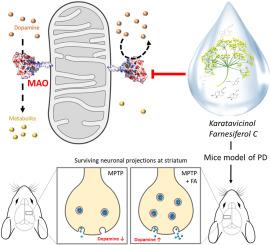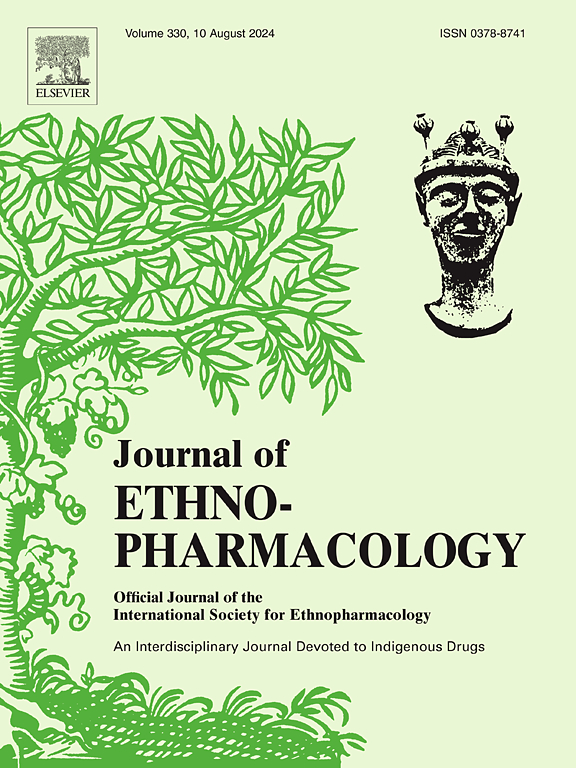活性引导下从阿fera assa-foetida中分离倍半萜香豆素作为单胺氧化酶抑制剂:研究其对帕金森病小鼠模型的治疗意义。
IF 5.4
2区 医学
Q1 CHEMISTRY, MEDICINAL
引用次数: 0
摘要
民族药理学相关性:阿魏作为一种香料已经使用了几个世纪,在阿育吠陀被公认为一种传统药物,并因其对神经系统的益处而成为全球民间医学。近年来,现代药理学研究增强了其治疗各种神经系统疾病的潜力,从而表明其在民族和现代医学方面治疗神经系统疾病的重要性。研究目的:我们旨在通过活性引导分离从阿Ferula assa-foetida中鉴定抑制单胺氧化酶(MAO)的倍半萜香豆素,并使用与帕金森病(PD)相关的体外和体内模型对其进行评估。材料和方法:采用LC-MS2检测倍半萜香豆素,色谱分离,半制备hplc介导纯化19个化合物;结合质谱、一维和二维核磁共振技术确定了它们的结构。MAO法鉴定出两种活性化合物,值得进一步研究。对SH-SY5Y细胞、果蝇和C57BL/6小鼠进行毒性评价。采用LC-MS/HPLC检测其对小鼠脑MAO活性和纹状体多巴胺的影响。最后,在mptp诱导的PD小鼠模型中验证了神经保护作用。结果:LC-MS2分析证实阿魏油胶树脂中存在结构多样性显著的倍半萜香豆素杂种化合物,并分离出19个化合物进行鉴定。初步体外MAO测定后,选择卡拉他维酚和法尼弗醇C进行进一步评价。两种化合物均表现出血脑屏障通透性,抑制小鼠大脑MAO活性,并有效提高纹状体多巴胺水平。此外,这些化合物在小鼠模型中显示出对PD的治疗潜力。结论:具有不同倍半萜结构的7种取代香豆素具有不同程度的MAO抑制作用。对卡拉他维酚和法尼弗醇C的进一步详细研究证实,这两种化合物在治疗帕金森病相关的多巴胺缺乏、运动不协调和神经变性方面具有显著的治疗潜力。本文章由计算机程序翻译,如有差异,请以英文原文为准。

Activity-guided isolation of sesquiterpene coumarins from Ferula assa-foetida as monoamine oxidase inhibitors: Investigation on their therapeutic implications in a mice model of Parkinson's disease
Ethnopharmacological relevance
Ferula assa-foetida, has been used for centuries as a spice, is well acknowledged as a traditional medicine in Ayurveda, and as a folklore medicine across the globe for its neurological benefits. In recent years, modern pharmacological studies have augmented its potential against various neurological disorders, thus signifying its therapeutic importance against neurological disorders in both ethnic and modern medicinal aspects.
Aim of the study: We aimed to identify Monoamine oxidase (MAO)-inhibiting sesquiterpene coumarins from Ferula assa-foetida through activity-guided isolation and evaluate them using in vitro and in vivo models relevant to Parkinson's disease (PD).
Materials and methods
LC-MS2 was used for the detection of the sesquiterpene coumarins, followed by chromatographic fractionation, and semi-preparative HPLC-mediated purification of the 19 compounds; their structures were established by the combined use of MS, 1D, and 2D NMR techniques. MAO assay identified two active compounds for further study. Toxicity was evaluated in SH-SY5Y cells, Drosophila, and C57BL/6 mice. Effects on mice brain MAO activity and striatal dopamine were examined by LC-MS/HPLC. Finally, neuroprotective effects were validated in an MPTP-induced PD mouse model.
Results
LC-MS2 analysis confirmed the presence of naturally occurring sesquiterpene coumarin hybrids with significant structural diversity in Ferula assa-foetida oleo-gum-resin, and 19 compounds were isolated for characterization. After preliminary in vitro MAO assays karatavicinol and farnesiferol C were selected for further evaluation. Both compounds exhibited BBB permeability, inhibited MAO activity in mice brain, and effectively elevated dopamine levels in the striatum. Additionally, these compounds demonstrated their therapeutic potential against PD in a mice model.
Conclusions
The 7 substituted coumarins with the structurally diverse sesquiterpene moieties displayed varying degrees of MAO inhibition. Further detailed investigation on karatavicinol and farnesiferol C confirmed that both compounds holds significant therapeutic potential to address PD related dopamine deficiency, motor incoordination, and neurodegeneration.
求助全文
通过发布文献求助,成功后即可免费获取论文全文。
去求助
来源期刊

Journal of ethnopharmacology
医学-全科医学与补充医学
CiteScore
10.30
自引率
5.60%
发文量
967
审稿时长
77 days
期刊介绍:
The Journal of Ethnopharmacology is dedicated to the exchange of information and understandings about people''s use of plants, fungi, animals, microorganisms and minerals and their biological and pharmacological effects based on the principles established through international conventions. Early people confronted with illness and disease, discovered a wealth of useful therapeutic agents in the plant and animal kingdoms. The empirical knowledge of these medicinal substances and their toxic potential was passed on by oral tradition and sometimes recorded in herbals and other texts on materia medica. Many valuable drugs of today (e.g., atropine, ephedrine, tubocurarine, digoxin, reserpine) came into use through the study of indigenous remedies. Chemists continue to use plant-derived drugs (e.g., morphine, taxol, physostigmine, quinidine, emetine) as prototypes in their attempts to develop more effective and less toxic medicinals.
 求助内容:
求助内容: 应助结果提醒方式:
应助结果提醒方式:


